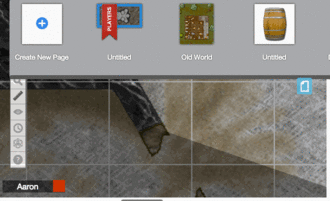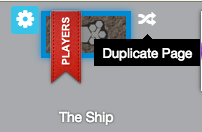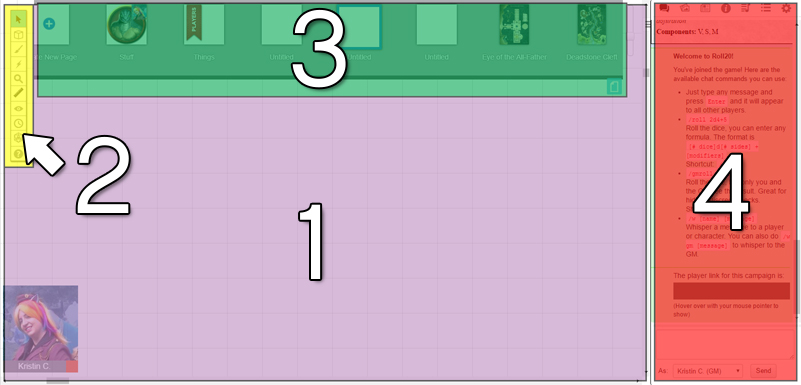Page Toolbar
From Roll20 Wiki
Attention: Roll20 is no longer maintaining this document on the community wiki. For the most up-to-date information please visit this page on our Help Center for assistance: Here. For more information you can email us at Team@roll20.net
In Roll20, a game is comprised of multiple Pages, like the pages from a storybook or the scenes in a storyboard. Each page represents an encounter, an NPC, an overland map, or some other discrete piece of the game. You can only view one page at a time.
Contents[hide] |
Page Toolbar
Managing Pages
You manage the pages of your Game by clicking on the Page Toolbar button in the top right-hand side of the screen (a blue button with a white icon of a page). The toolbar shows you all the pages currently in your game. You can drag and drop the pages to re-order them, or click on the name of the page to edit the name. The Page Toolbar can be scrolled horizontally by using your mouse wheel while holding your keyboard's Shift key.
If you hover over a page you'll also see two new buttons appear, one (a gear icon) for accessing the Page Settings dialog box, and the other (a crossed X) for duplicating the page. To delete the page, click on the gear and scroll to the bottom of the menu to find the red "Delete Page" button.
To create a new page, just click on the "Create New Page" button on the left-hand side of the Page Toolbar. Change the page's name by clicking on the name under the page's icon. Enter the new name and press Enter/Return to save.
Page Icons
The image used to represent a Page is the largest image on that page. If you would like to override the Page Icon, you can place the image you want to use (or duplicate an existing graphic that isn't the largest image) and then scale it up to a very large size. You can then right click the image and move it to the back of the layer to hide it beneath other images. See: Manipulating Graphics
Switching Between Pages
The GM can quickly switch between pages at any time by accessing the Page Toolbar and clicking on the page that they want to switch to. There will be a short loading sequence and the selected page will be displayed.
The players will see whichever page you place the Player Bookmark on. The Player Bookmark is a red ribbon with the word "Players" on it. You can click and drag to move it between pages, thus moving the players to that new page.
Note that is entirely possible that the GM and the players can be on a different page, so you can be constructing the next encounter while your players are still on a previous page.
Duplicate Page Settings
The Duplicate Page button will create a new page with the identical settings of the source page, but with none of the contents. This allows you to create a page with the movement options, scale, grid, etc all set the way you want it, and then add more pages with the same settings.Moving Tokens Between Pages
Sometimes you will want to move objects (such as tokens representing the players) between pages. To do so, just select the tokens, then press Ctrl+C (or Cmd+C on Mac) to copy them. Switch to the new page, then press Ctrl+V (or Cmd+V) to paste them onto the new page. The location that token will paste to is oriented from the last time you clicked on the tabletop.
Split the Party
Just drag-and-drop the "player" from the player area at the bottom of your screen, onto a page in the page toolbar at the top (while the toolbar is open). That will create a little icon for that player to show what page they are on. Drag and drop it onto a different page to switch that player between pages, or drag it back to the Player Bookmark to "reset" that player back to using the normal player bookmark ('rejoining the group', essentially).

Page Settings
There are a number of settings that you can change for each page, including the type of grid, enabling Fog of War, and more. For more details, consult the Page Settings help guide.
Related Pages
- Interface
- 1. The Tabletop
- 2. The Toolbox
- 3. Page Toolbar
- 4. The Sidebar













